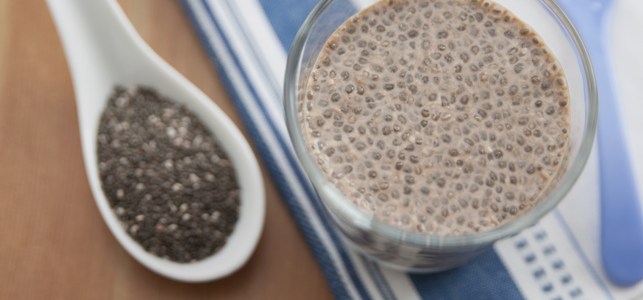You might be most familiar with chia seeds from their early incarnation as novelty “Ch-Ch-Ch-Chia” Pets in the 1970s and 80s, where sprouted chia seeds became the green “fur” on clay animals.
Although the Chia Pet fad faded away, chia seeds have found the limelight again as a new superfood. So what are chia seeds and just how “super” are they really?
Chia seeds are small (1 mm) seeds that grow on blue flowering stalks of the salvia hispanicaplant, a member of the mint family native to Mexico and Central America. Historically chia seeds were revered for their high energy and eaten as a staple by Aztecs and Mayans. It is reported that 1 tablespoon of chia seeds could sustain an Aztec warrior for 24 hours.
Extremely high in antioxidants and zinc, among other phytonutrients, chia seeds with their immune-boosting properties were also traditionally used to treat colds and flu, as well as to relieve joint pain and skin conditions. There’s even some evidence to suggest that chia seeds were so valuable to Aztecs that they were traded as currency.
Then, with the arrival of first Europeans to the Americas, chia crops were eradicated during the destruction of the Aztec culture. Prior to the mid 1970s only a few indigenous farmers grew chia seeds and so they remained virtually unknown outside of Mexico and Central America until recently. For centuries Chia seeds have also fueled the renowned Tarahumara Indians long-distance runners in Mexico’s Copper Canyon.
Today chia seeds can be found in health food stores and restaurants. They are used as a binder in foods like puddings—see Chocolate Chia Seed Pudding recipe below—and as a gelatinous substance in some chia fruit drinks.
Nutritional Benefits of Chia Seeds
New York Times bestselling author, Christopher McDougall writes about chia seeds in his book about the Tarahumara Indians, Born to Run:
“In terms of nutritional content, a tablespoon of chia is like a smoothie made from salmon, spinach, and human growth hormone. As tiny as those seeds are, they’re packed with omega-3s, protein, calcium, iron, zinc, fiber, and antioxidants. If you had to pick just one desert-island food, you couldn’t do much better than chia, at least if you were interested in building muscle, lowering cholesterol, and reducing your risk of heart disease; after a few months on the chia diet, you could probably swim home.”
Chia seeds are packed with nutritional benefits. One ounce (about two tablespoons) of chia seeds is high in protein (4.4 grams), omega-3 fatty acids (5 grams), and fiber (11 grams). They’re also high in several key minerals, with one ounce of chia seeds containing 179mg of calcium, 95mg of magnesium, 244mg of phosphorous, and 115mg of potassium.
Packed with phytonutrients, chia seeds boost the immune system, support bone-building health, and improve hair, skin, and nails. Chia seeds have strong anti-inflammatory properties that may help reduce joint inflammation, and recent research suggests that they may also provide some protection from breast cancer.
And unlike flax seeds, chia seeds don’t need to be ground up to make their nutritional benefits bio-available; they can be eaten whole.
Chia Seeds for Weight Loss
Though there are many chia seed weight-loss claims out there, studies at several universities have not shown any correlation between chia seed diets and actual weight loss.
That said, chia seeds have been touted for weight loss because they pack a lot of protein and fiber into a small amount of food, helping to slow digestion and suppress the appetite by making you feel full. One of the ways chia seeds can make you feel full is by expanding in your stomach during digestion. Interestingly, chia seeds act like sponges absorbing about 12 times their volume when exposed to water.
Because of their hydrophilic (water-absorbing) properties, you should drink plenty of water when eating dry chia seeds so they don’t pull water out of your system as they expand. Alternatively you can soak them in water before eating them.
When used in cooking and baking, chia seeds absorb a lot of the moisture content, plumping up to act as a binder or filler, with a consistency similar to cooking with flax seed meal or tapioca. This is one reason their consistency makes such a great pudding, similar to tapioca.
Health Risks of Chia Seeds
While chia seeds have many wonderful nutritional benefits, they also have a few potential side effects. Due to their high omega-3 content, chia seeds can cause thinning of the blood, so it’s recommended that you talk to your doctor before eating them if you’re on blood thinners, taking aspirin regularly, or are having surgery.
Studies on heart disease and diabetes have shown chia seeds to be effective at lowering blood pressure and controlling blood sugar. Studies also indicate that chia seeds may boost the effects of blood pressure and blood sugar medications. If you take medications for diabetes or heart disease, chia seeds can interact with those medications, so it’s a good idea to consult your doctor before eating them.
Though allergies to chia seeds are uncommon, there is some evidence to suggest that cross-reactivity (when the immune system confuses one food for another molecularly similar food and causes an immune response) can exist between chia seeds and certain foods that are molecularly similar, including thyme, oregano, mustard, and sesame.
Chia seeds have also been known to cause gastric distress both in the form of constipation or diarrhea, due to their high fiber content. It’s interesting to note that ancient Aztecs also used chia seeds as a laxative.
Taking bio-individuality into account (meaning that every body is slightly different and what works well for one body may not work for the next body), if you’re new to eating chia seeds you may want to start in moderation, with just one teaspoon, and build up from there.
Tip: Make sure your chia seeds are GMO-free.
If you’re eager to try chia seeds but don’t know where to start, try this easy-to-make chia seed pudding.
Chocolate Chia Pudding
Gluten-free | Vegan
Ingredients
- 4 tablespoons black chia seeds
- 3 tablespoons cacao powder
- 2 tablespoons organic raw honey or organic maple syrup
- 1 13.5oz.-can of coconut milk (or other non-dairy milk)
- Pinch of sea salt
- Quart size glass jar with lid
Directions
Place all of the ingredients in the order listed, into a quart size glass jar.
Stir ingredients together, put the lid on and shake it well for a few minutes to mix everything thoroughly.
Refrigerate until thick and pudding-like, at least 4 to 8 hours, shaking or stirring occasionally.
Serve the pudding chilled with toppings if you’d like. See suggested toppings below.
Serves 4
– See more at: http://www.chopra.com/ccl/chia-seeds-miracle-food-or-just-another-fad?utm_source=Newsletter&utm_medium=Email&utm_content=Newsletter%20150427&utm_campaign=April#sthash.UbBTSabh.dpuf





 Hi I’m Catherine, founder of Wine Women And Chocolate. Want to become a contributor for Wine, Women & Chocolate? Interested in sharing your unique perspective to a group of supportive, like-minded women?
Hi I’m Catherine, founder of Wine Women And Chocolate. Want to become a contributor for Wine, Women & Chocolate? Interested in sharing your unique perspective to a group of supportive, like-minded women?